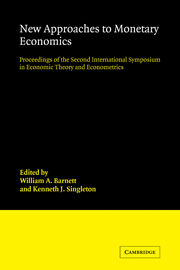 New Approaches to Monetary Economics
New Approaches to Monetary Economics Book contents
- Frontmatter
- Contents
- Editors' introduction
- List of contributors
- Part I Transactions motivated monetary holdings in general equilibrium
- Part II Financial intermediation
- Part III Monetary aggregation theory
- Part IV Issues on aggregate fluctuations
- 12 Asset prices in a time-series model with disparately informed, competitive traders
- 13 Nominal surprises, real factors, and propagation mechanisms
- 14 A rational expectations framework for short-run policy analysis
- Part V Theoretical issues in the foundations of monetary economics and macroeconomics
12 - Asset prices in a time-series model with disparately informed, competitive traders
Published online by Cambridge University Press: 04 August 2010
- Frontmatter
- Contents
- Editors' introduction
- List of contributors
- Part I Transactions motivated monetary holdings in general equilibrium
- Part II Financial intermediation
- Part III Monetary aggregation theory
- Part IV Issues on aggregate fluctuations
- 12 Asset prices in a time-series model with disparately informed, competitive traders
- 13 Nominal surprises, real factors, and propagation mechanisms
- 14 A rational expectations framework for short-run policy analysis
- Part V Theoretical issues in the foundations of monetary economics and macroeconomics
Summary
Introduction
Surveys of the participants in organized securities markets indicate that traders hold widely different beliefs about the future course of economic activity. Expectations not only differ, but they evidently respond significantly to unexpected movements in such variables as real economic growth and the weekly changes in the money stock [see Cornell (1983) for a review of some of this literature]. Furthermore, French and Roll (1984) have found that the variance of stock prices is greater over periods when the stock market is open than when it is closed. Together, these observations suggest that disparate beliefs and the sharing of information through the trading process may be important ingredients in modeling asset-price determination. The purpose of this paper is to explore the implications of disparate expectations for the time-series properties of asset prices in the context of a simple model with competitive traders facing serially correlated shocks.
While the models examined are partial equilibrium in nature, this exploration is motivated in part by the apparent inconsistency of representative agent, dynamic equilibrium models with the behavior of asset prices. The variances and autocorrelation functions of asset returns seem to be inconsistent with the implications of both linear expectations models [see, e.g., Shiller (1979, 1981), Singleton (1980, 1985), Scott (1985)] and the nonlinear models studied by Hansen and Singleton (1982), Ferson (1983), Dunn and Singleton (1985), and Eichenbaum and Hansen (1985), among others.
- Type
- Chapter
- Information
- New Approaches to Monetary EconomicsProceedings of the Second International Symposium in Economic Theory and Econometrics, pp. 249 - 272Publisher: Cambridge University PressPrint publication year: 1987
- 31
- Cited by


